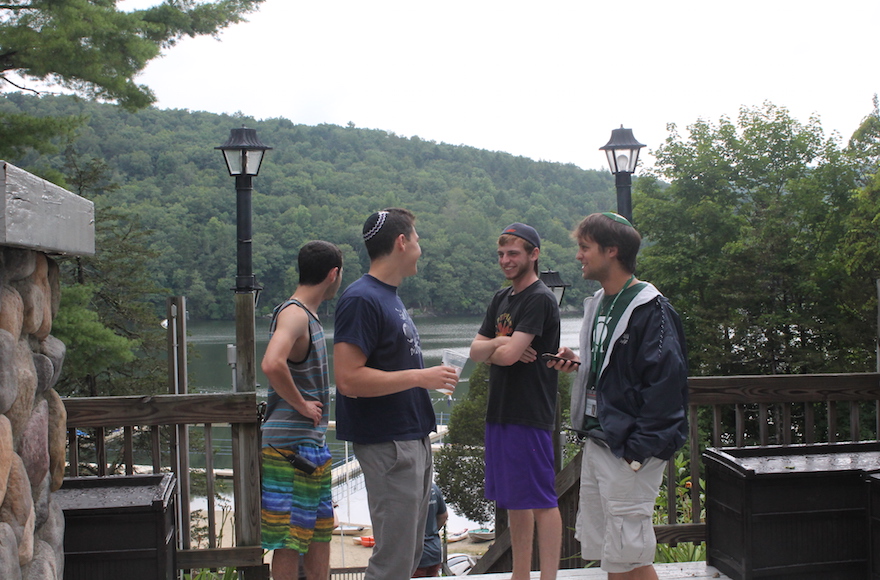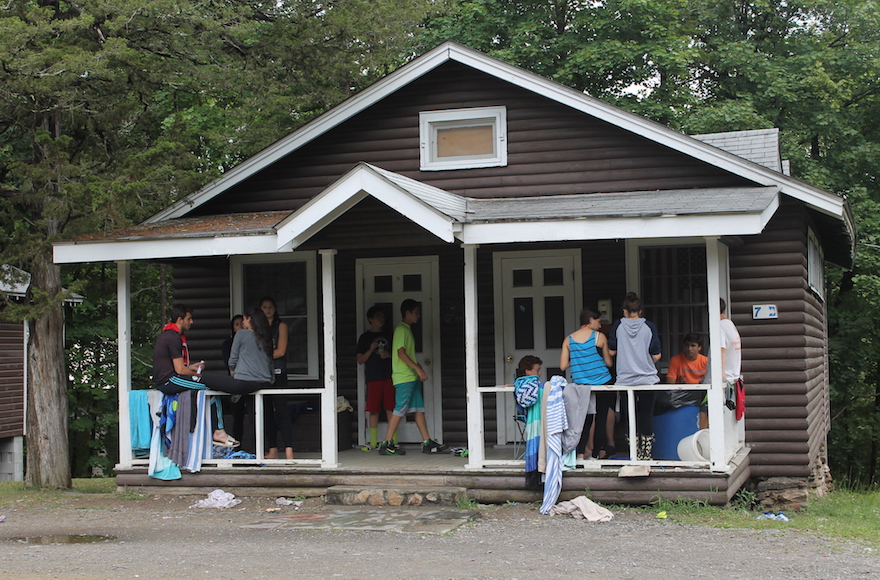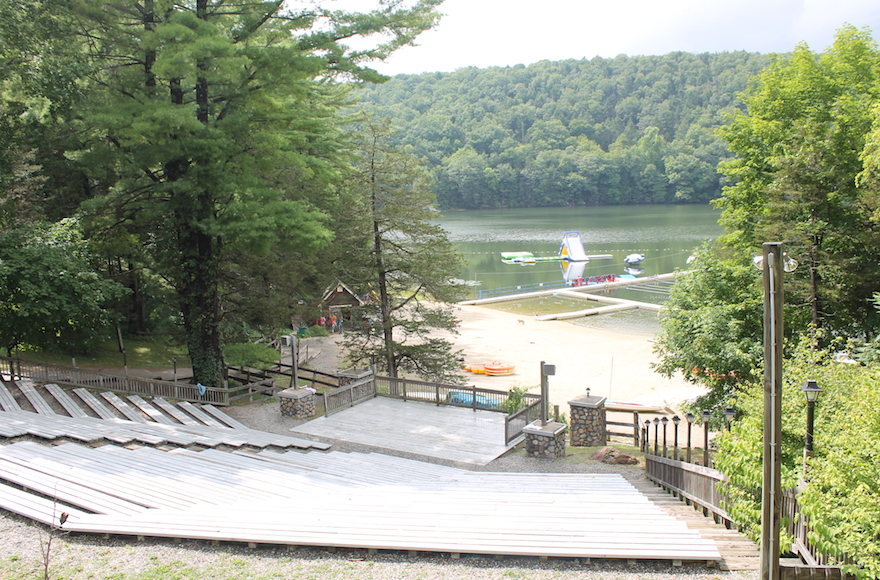Ramah camps a bright spot for Conservative movement, but 9 of 10 kids don’t go
Published February 28, 2016

Judaism infuses everything at Ramah camps, from sports to art to the dining hall, campers and staff say. (Uriel Heilman)
WINGDALE, N.Y. (JTA) – The sky is clearing after a damp morning at Camp Ramah in the Berkshires, and kids are emerging from their cluttered bunks.
An impromptu Frisbee game breaks out on the lawn, while down by the lake a counselor prepares the water trampoline and surf kayaks. On the other side of the 200-acre expanse, a staffer tests the high ropes obstacle course. Nearby, a group of teenagers is shooting hoops at the covered basketball courts, where industrial fans turn the sultry air.
There’s something else going on at this camp, Ramahniks say, though it may not be as visible: inculcation of Jewish values. Every day begins with prayer, Hebrew suffuses the camp vernacular, counselors sprinkle discussions of Jewish ethics into nearly every activity and Friday night is many campers’ favorite time of the week.
“It’s a Conservative Jewish utopia,” said counselor Deborah Pollack, 21. “You can get Jewish values on the sports field, doing art. We can all find our access points here. I really grew all my passion for Judaism here.”
By nearly all accounts, the Ramah network of Conservative Jewish summer camps is one of the brightest spots in the Conservative movement, which has seen notable declines in affiliation, congregational membership and the fiscal health of its central institutions over the last two decades.
READ: Amid identity crisis, Conservative Jews pay for rebranding
Counselors and alumni alike describe their Ramah experiences as among the most formative of their childhoods, if not the primary influence on their Jewish identity, and Ramah draws campers from across the denominational spectrum, from Orthodox to unaffiliated. Three new Ramah camps have opened since 1997, and a fourth will be added this summer.
It’s not hard to see why campers and counselors love Ramah: As at other summer camps, it’s a home away from home where kids get to hang out with their friends all the time and have fun.
For Ramahniks, 50 percent of whom attend public schools, it’s also a place where young Jews can revel in their Jewish identity without feeling like outsiders, and where doing Jewish is seen as cool. That sensation is not always easy to come by at synagogue or Hebrew school.

More than 750 campers and 300 counselors went to Camp Ramah in the Berkshires in the summer of 2015. (Uriel Heilman)
“Here you’re allowed to explore whatever type of Judaism you’re comfortable with,” said Sam Teitelbaum, 23, who has been going to Ramah in the Berkshires for 14 summers. “Hebrew school can only do so much. Camp has had a huge impact on my life. Everything I know about Judaism has come from camp. I met my girlfriend at camp.”
Studies long have pointed to Jewish summer camp as one of the most effective ways to excite young people about Jewish life and identity, and there’s been an explosion of new Jewish summer camps over the past few years as faith in the efficacy of summer camps has taken hold in the Jewish organizational world. (“Camp Works” was the title of a much-circulated 2011 study commissioned by the Foundation for Jewish Camp on the long-term impact of Jewish overnight camp.)
What makes Ramah distinct, say its fans, is that it’s a place to cultivate and celebrate a brand of Judaism that is serious, yet pluralistic and joyful – the hallmarks of what the Conservative movement aspires to be.
“It’s a community infused with Conservative Jewish doctrine — from kashrut to Shabbat to daily prayer,” said Jason Miller, a Conservative rabbi and entrepreneur in Detroit who worked for three summers at Ramah while in rabbinical school. “The magic of the Camp Ramah experience is that it’s a 24/7 shtetl of Jewish life. It gives the children and staff a four- or eight-week taste of what that type of Jewish living is all about.”
Mitch Cohen, national director of Ramah, says the camps have become a magnet for parents looking to give their kids a strong Jewish identity.
“This is a place where we live Judaism 24/7,” Cohen told JTA. “We’re not the only camps that do it well, but many camps are just camps for Jews with only a few Jewish programs. At Ramah, Jewish education is part of the fabric of camp life.”
Ramah, which operates as a subsidiary of the Jewish Theological Seminary, the Conservative movement’s flagship academic institution, now has nine overnight camps and four day camps in the United States and Canada — including the new Camp Ramah in Northern California due to open this summer.

The waterfront at Camp Ramah in the Berkshires includes a wide variety of inflatable toys and surf kayaks. (Uriel Heilman)
In all, that’s about 10,000 campers and staff per year, according to Cohen. Still, he pointed out, that figure is only 6-7 percent of camp-age kids in the Conservative movement.
“Our biggest failure is that we don’t grow faster,” Cohen said, noting that not a single new Ramah sleepaway camp opened between 1964 and 1997.
Over the past 20 years, Ramah has added overnight camps in Georgia (Ramah Darom in 1997), Colorado (Ramah in the Rockies in 2010) and California. A new Ramah day camp opened last summer in the Washington, D.C., area.
“There’s plenty of market share out there for us to grow in,” Cohen said.
Yet some alumni say that while Ramah is doing a great job, the Conservative movement should support alternative camps that can appeal to the 90 percent of Conservative kids not going to Ramah because of the perception that it’s too religious.
According to Cohen, there are more modern Orthodox kids at Ramah than children from liberal or unaffiliated Jewish families: About 70 percent of Ramah campers come from Conservative synagogues, 15-20 percent from modern Orthodox homes, 8 percent from unaffiliated families, and 5 percent from the Reform or Reconstructionist movements.
“Ramah was designed as a leadership camp for the intellectual leadership of the Conservative movement,” said one Ramah alumnus who asked to remain anonymous. “But the Conservative movement’s problem is not so much a lack of leadership as a lack of followership. For the vast majority of Conservative Jews, Ramah is way too Jewy. Where are the Conservative movement camps for them?”
Cohen acknowledged that many Conservative-affiliated families think of Ramah in this way, yet he said those who “take the time to get to know the real Ramah find our Jewish and religious programming very accessible.” Among the other reasons Conservative families don’t send their kids to Ramah is the cost (about $9,000 for a full summer at Ramah in the Berkshires) and the myriad other summer options out there, Cohen said.
Yet in many Conservative communities, Ramah is presented as the only option. Some Conservative synagogues won’t allow representatives of camps other than Ramah to recruit there.
“I grew up with a rabbi who said from the bimah: If you don’t send your child to Ramah, you were doing something wrong,” said Jeremy Fine, a rabbi in Minnesota.
Meanwhile, Ramah is trying to export its magic formula to the rest of the movement. Several years ago the network launched the Ramah Service Corps fellowship, a program for Ramah alumni to try to bring Ramah’s spirit and style to local communities and synagogues throughout the year. The Ramah alumni association, Reshet Ramah, is similarly committed.
“We no longer look at ourselves as just a camp,” said the longtime director of Ramah in the Berkshires, Rabbi Paul Resnick. “We’re a community-building enterprise.”
(JTA’s special section on camps, made possible with funding from the Foundation for Jewish Camp, examines trends affecting Jewish overnight camps.)
This entry passed through the Full-Text RSS service – if this is your content and you’re reading it on someone else’s site, please read the FAQ at fivefilters.org/content-only/faq.php#publishers.














